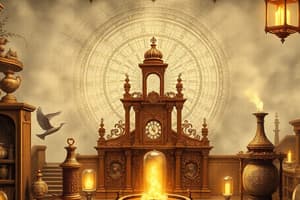Podcast
Questions and Answers
What does the law of conservation of mass state?
What does the law of conservation of mass state?
- Mass can be created or destroyed in a chemical reaction.
- Mass can neither be created nor destroyed in a chemical reaction. (correct)
- The mass of products always exceeds the mass of reactants.
- All reactions involve a change in mass.
The law of constant proportions states that compounds are composed of the same elements in different ratios depending on their source.
The law of constant proportions states that compounds are composed of the same elements in different ratios depending on their source.
False (B)
Who laid the foundation of chemical sciences by establishing important laws of chemical combination?
Who laid the foundation of chemical sciences by establishing important laws of chemical combination?
Antoine Lavoisier
Dalton's ______ theory describes matter as composed of small particles called atoms.
Dalton's ______ theory describes matter as composed of small particles called atoms.
Match the following concepts with their descriptions:
Match the following concepts with their descriptions:
What is the ratio of the mass of hydrogen to the mass of oxygen in water?
What is the ratio of the mass of hydrogen to the mass of oxygen in water?
According to Dalton's theory, atoms can be created and destroyed in a chemical reaction.
According to Dalton's theory, atoms can be created and destroyed in a chemical reaction.
What does the law of constant proportions state?
What does the law of constant proportions state?
The smallest particles of matter, as proposed by Dalton, are called _____
The smallest particles of matter, as proposed by Dalton, are called _____
Match the following statements with their corresponding atomic principles:
Match the following statements with their corresponding atomic principles:
Flashcards
Law of Conservation of Mass
Law of Conservation of Mass
In a chemical reaction, mass is neither created nor destroyed.
Law of Constant Proportions
Law of Constant Proportions
Compounds always have the same elements in fixed proportions, no matter the source.
Chemical Reaction
Chemical Reaction
A process where substances rearrange to form new substances.
Antoine Lavoisier
Antoine Lavoisier
Signup and view all the flashcards
Dalton's Atomic Theory
Dalton's Atomic Theory
Signup and view all the flashcards
Atomic Theory Postulate (i)
Atomic Theory Postulate (i)
Signup and view all the flashcards
Atomic Theory Postulate (ii)
Atomic Theory Postulate (ii)
Signup and view all the flashcards
Atomic Theory Postulate (v)
Atomic Theory Postulate (v)
Signup and view all the flashcards
Study Notes
Ancient Indian and Greek Philosophers
- Ancient Indian and Greek philosophers pondered the divisibility of matter
- Indian philosopher Maharishi Kanad proposed that matter could be divided into smaller and smaller particles, eventually reaching indivisible particles called Parmanu
- Greek philosophers Democritus and Leucippus suggested indivisible particles called atoms
- These ideas were based on philosophical reasoning rather than experimentation
Law of Conservation of Mass
- Lavoisier and Proust demonstrated that mass is conserved in a chemical reaction
- This means the total mass of the reactants equals the total mass of the products
Law of Constant Proportions
- Lavoisier and Proust observed that elements always combine in fixed proportions to form a given compound
- This proportion is constant regardless of the source or method used to prepare the compound
Dalton's Atomic Theory
- Dalton proposed an atomic theory based on the laws of chemical combination
- Key postulates of the theory:
- All matter is made of atoms
- Atoms are indivisible and indestructible
- Atoms of the same element are identical in mass and properties
- Atoms of different elements have different masses and properties
- Atoms combine in whole number ratios to form compounds
Atomic Mass
- Atomic mass is the relative mass of an atom compared to 1/12 the mass of a carbon-12 atom
- This is a relative value, not an absolute one
- Dalton's theory explained the law of conservation of mass and the law of constant proportions
Atoms, Molecules, and Ions
- Atoms of most elements do not exist independently, they exist as molecules or ions
- Molecules are groups of atoms chemically bonded together
- Atoms of the same element may form molecules of different compositions or atomicity
- Ions are charged particles, either negative (anions) or positive (cations)
Chemical Formulae
- Chemical formula provides a symbolic representation of composition
- The rules for writing chemical formulae:
- Valency determines the number of atoms in a compound
- Use brackets for compounds containing multiple polyatomic ions
- Simple compounds are made of two types of elements
Studying That Suits You
Use AI to generate personalized quizzes and flashcards to suit your learning preferences.




